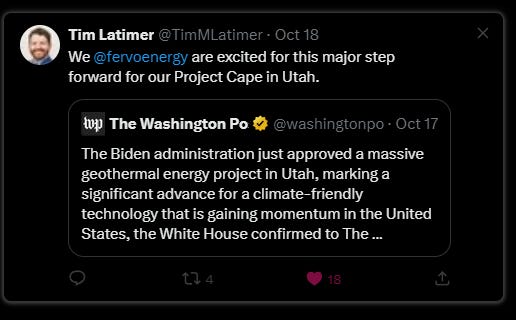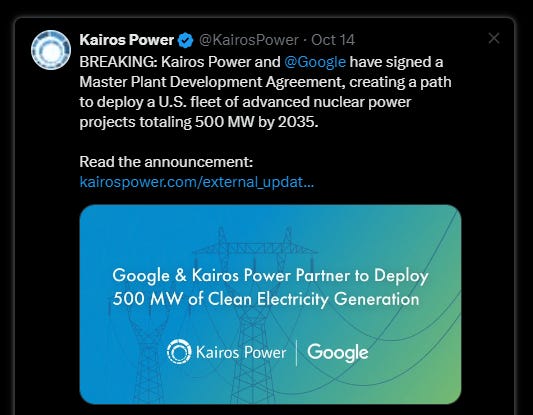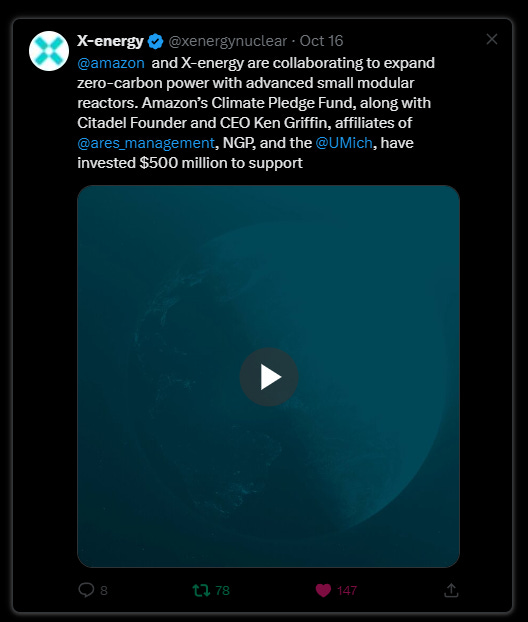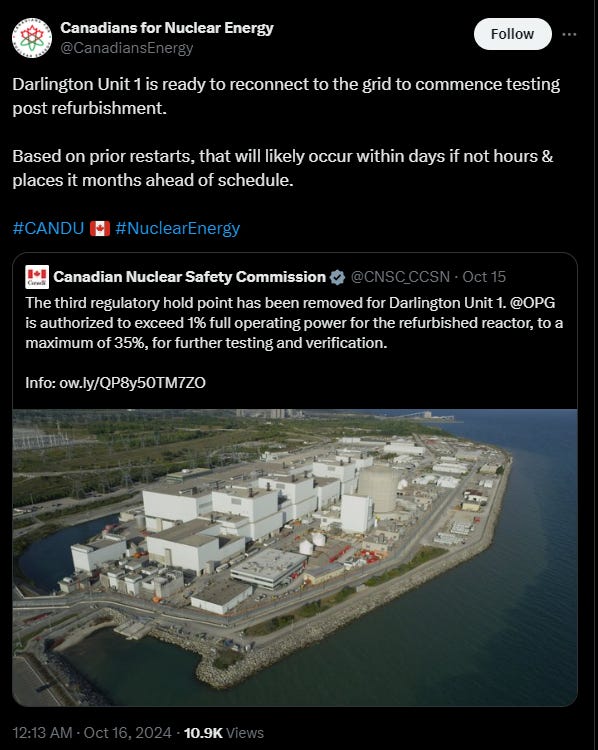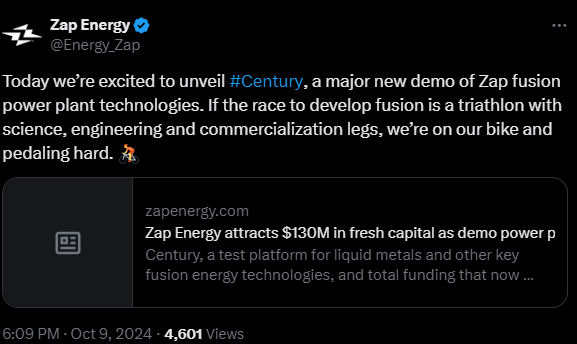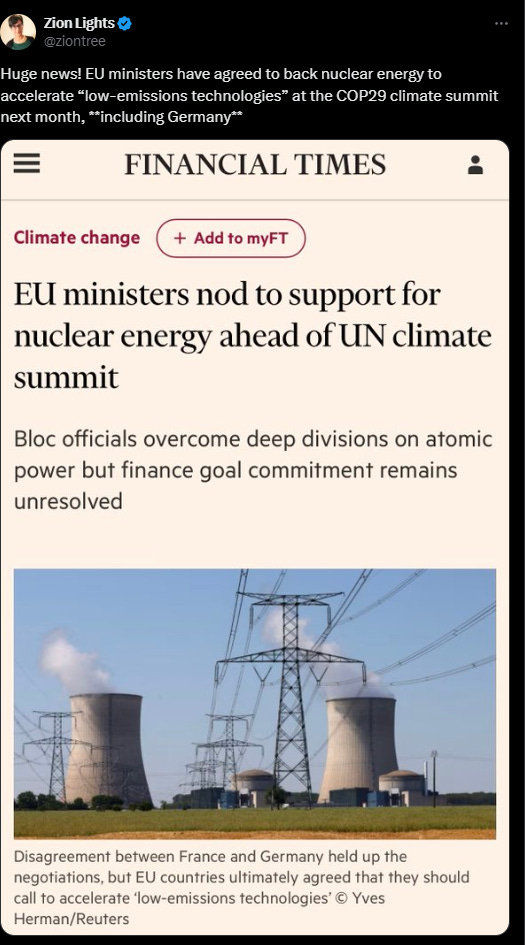Zero-carbon energy abundance
... coming faster than you think
The last few weeks have been an unrelenting stream of positive news for clean energy in the West.
Driven by the rapid predicted increase in electricity demand for electric vehicles, A/C, and computing, companies that rely on dependable energy and are interested in zero-carbon solutions, have changed from consuming fossil fuels and buying licenses to blame other people for their emissions, to looking into options that can physically satisfy their needs.
One option that keeps beating financial expectations and timelines is geothermal power. For example @fervoenergy has partnered with @Google to provide data centers and campuses with 24/7 carbon-free power. Additional,@fervoenergy plans to build 400 MWe of power in Utah over the next 4 years, which just got regulatory approval.
@Google announced another partnership with @KairosPower to deploy 500MW of clean nuclear power.
Their KP-FHR reactor combines molten salt cooling and solid TRISO fuel, a special fuel form that is known for its (almost absurdly high) security levels.
A TRISO fuel element consists of thousands of tiny, spherical uranium particles, each one coated in a tough containment consisting of mulitple layers of specially designed materials.
TRISO particles had been irradiated to previously unseen levels of burn-up and therefore fission product content (as bad as it can be) and were than tested at up to 1800°C and showed no to little damage and full fission product retention.
These temperatures are well beyond anything that can be achieved in worst case accident scenarios, which means it cannot melt down.
If the fuel were nonetheless damaged, the fission products would be retained by the molten salt coolant and would not be dispersed into the environment.
@Xenergy 's helium-cooled Xe-100 reactor also relies on TRISO fuel, which they produce in their own production. @amazon seems so convinced of the design that they just invested $500M with the goal of deploying up to 5 GWe of clean power by 2039. The reactor has also been selected for Dow’s UCC Seadrift Operations manufacturing site in Texas, where it is expected to provide reliable, zero-carbon-emissions power and steam.
@WECNuclear's also uses TRISO fuel for their eVinci reactor, which is supposed to become the research reactor of choice and an energy source for remote locations - think radar stations in Alaska -, where energy comes at a premium.
hat is rougly the same market that @UltraSafeNuke 's is trying to address with their own reactors and their fuel products, based on TRISO. They are also pretty serious about deploying their reactors on the moon or on Mars. Which is - if you think about it - as remote and hostile a location as you can imagine. They are also looking into powering rockets in space with it.
The @NRCgov has issued a construction permit to @ACUedu to build the Natura MSR-1 research reactor. It will be the first reactor, where the fuel is dissolved in molten salt, to be built and operated in the US in over 30 years. The reactor will also serve as testbed for the design before its commercialization.
Not to be outdone by the other hyperscalers, @Microsoft partners with
@ConstellationEG to restart the venerable TMI-1 reactor to secure 20 years of reliable zero-carbon energy.
@holtecintl is working on bringing back another reactor from the dead: Palisades. They secured a loan from @ENERGY and are apparently on track to with their restart program.
But there are only so many old reactors that you can bring back, and startups like @TheNuclearCo are planning to build the already proven Gen3 nuclear power plants, that have served us so well, in fleet mode. That is based on the idea that you need to "do" to get better at "doing", especially, if you set out to do something as big as power plant construction.
Canda is proving this point. They have been refurbishing their power plants and have it down to a science. These gigantic projects are now regularly completed months before schedule.
CANDU reactors have a stellar record. They are well suited for nuclear "beginner" states - and for states that have lost the ability for heavy forgings that are necessary for pressurized water reactors. That is because the core consists of many smaller pipes, which are easy to manufacture relative to the foot-thick forgings needed in PWRs.
The same supply chain that is needed for refurbishments could also be used for new builds globally. A good thing, considering that Romania is considering to complete two units.
India has developed an entirely indigenousversion of this reactor and is deploying it in fleet mode.
Reactor developer @COREPOWER10 is scoring major investment. They are trying to commercialize a molten salt reactor for powering ships.
@Blue_Energy_Co scored a $45M investment to develop their "modular power plants from modular reactors idea". They are reactor agnostic, partnering with reactor vendors and designing modular power plants to house them.
In the fusion space, we continue to see a lot of energy and investments. @Energy_Zap recently landed a major investment and unveiled its power plant design:
Even in the EU, where nuclear power has eked out a miserable existence (especially in Germany), there are some signs of an improving environment.
Nuclear will be considered clean. It might strike any sensible observer as ridiculous to claim otherwise, given the miniscule amounts of waste, the low resource intensity and zero-carbon electricity, but you have to count it as a win:
The energy abundance agenda is gaining much deserved speed and only our own stupidity and anti-rational ideology can stop us from providing clean energy - in due time - to everyone.


